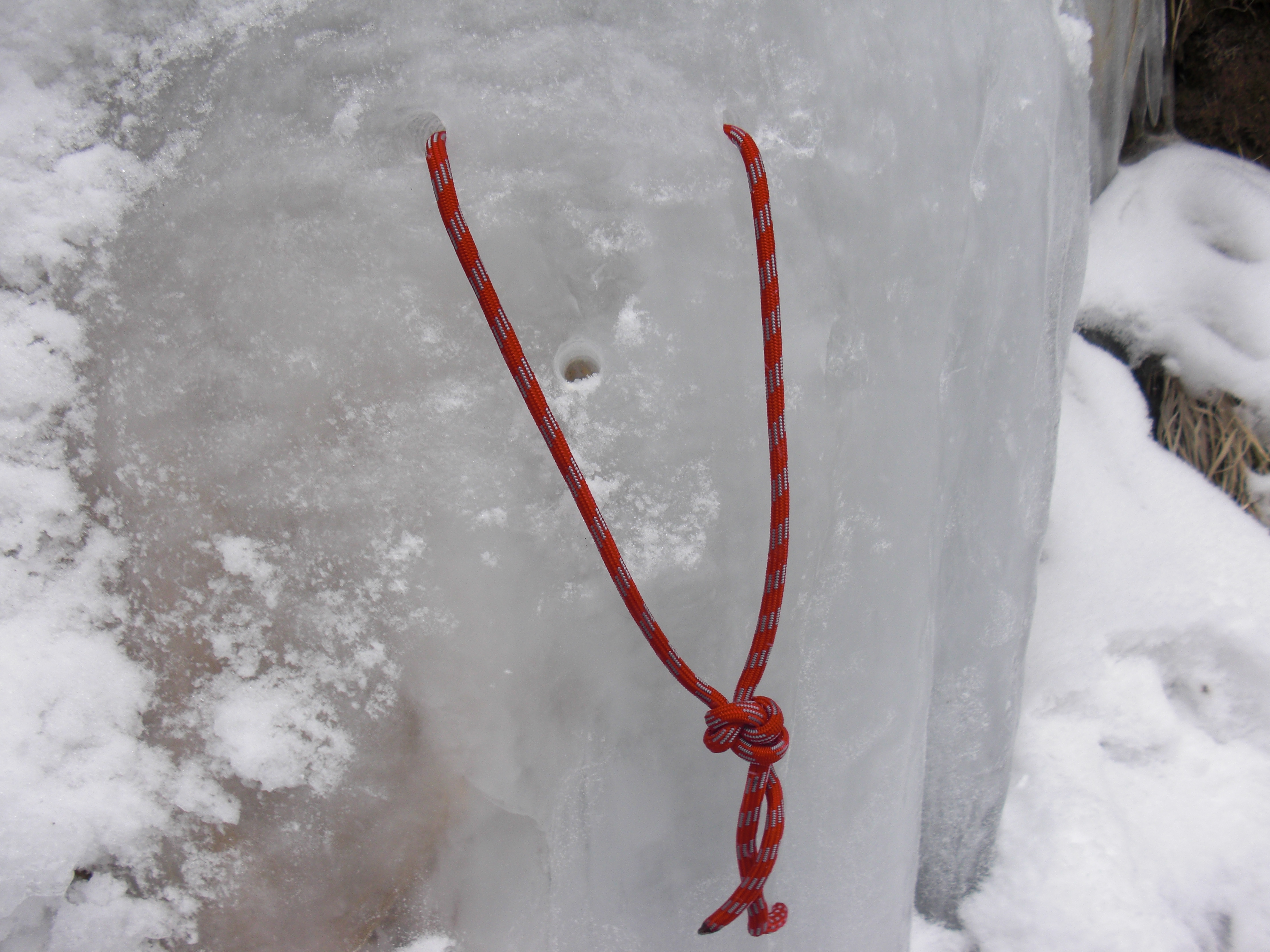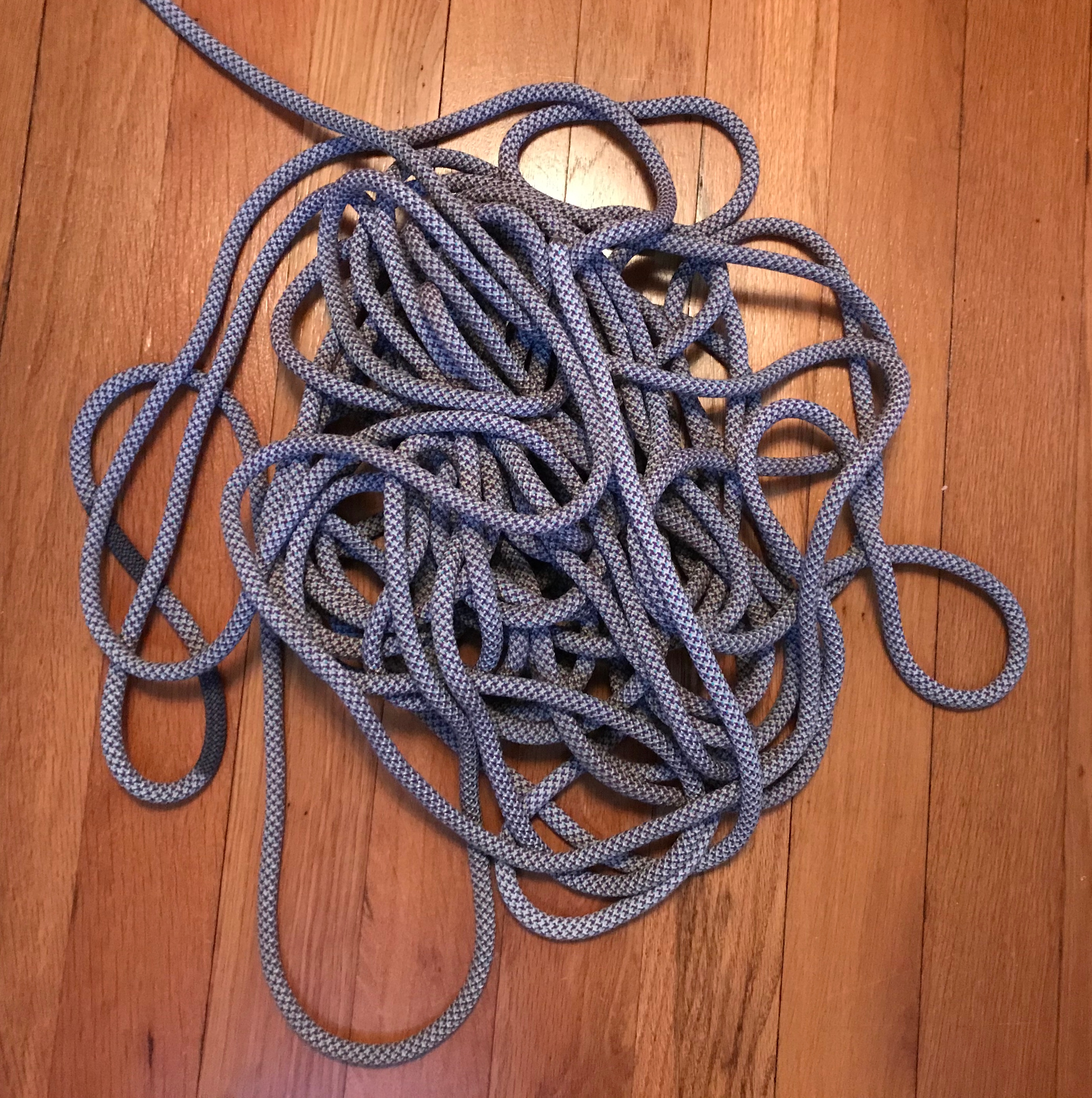|
Picket (climbing)
Snow protection (snow pro) is a type of natural or artificial protection used in mountaineering as an anchor. Two common artificial devices are the snow fluke and snow picket. It is used both for climbing and for securing tents and other camping gear, designed for use in sand and snow. A fluke is a bent square or rectangle, approximately , and is made of aluminium or other metal, with a cable attached at two points on the upper surface. A fluke correctly used is buried in the snow, tip pointed down, approximately 40° from the angle of the mountain slope. Flukes can deflect or dislodge in harder-packed or dry snow, and are therefore more reliably used in heavy, moist snow. A picket is usually made of lightweight aluminum in long T-shaped design. See also * Glossary of climbing terms * Mountaineering Mountaineering or alpinism, is a set of outdoor activities that involves ascending tall mountains. Mountaineering-related activities include traditional outdoor climbing, ski ... [...More Info...] [...Related Items...] OR: [Wikipedia] [Google] [Baidu] |
Pickett02
Pickett is an English surname. It is a variant form of Pigott. Notable people with the surname include: * Adarius Pickett (born 1996), American football player * Albert J. Pickett (1810–1858), American historian * Allison Deforest Pickett (1900–1991), Canadian entomologist *Allistair Pickett (born 1973), Australian rules footballer *Bill Pickett (1870-1932), American cowboy and rodeo performer * Bob Pickett (American football) (1932–2010), American football player *Bobby Pickett (1938–2007), American singer *Brad Pickett (born 1978), British mixed martial arts fighter *Byron Pickett (born 1977), Australian rules footballer * Carroll Pickett (born 1933), American Presbyterian minister *Carson Pickett (born 1993), American women's soccer player * Charles E. Pickett (1866–1930), American politician from Iowa *Cindy Pickett (born 1947), American actress * Cody Pickett (born 1980), Canadian footballer * Cornelius A. Pickett (1902–1990), American politician and Mayor of Hous ... [...More Info...] [...Related Items...] OR: [Wikipedia] [Google] [Baidu] |
Mountaineering
Mountaineering or alpinism, is a set of outdoor activities that involves ascending tall mountains. Mountaineering-related activities include traditional outdoor climbing, skiing, and traversing via ferratas. Indoor climbing, sport climbing, and bouldering are also considered variants of mountaineering by some. Unlike most sports, mountaineering lacks widely applied formal rules, regulations, and governance; mountaineers adhere to a large variety of techniques and philosophies when climbing mountains. Numerous local alpine clubs support mountaineers by hosting resources and social activities. A federation of alpine clubs, the International Climbing and Mountaineering Federation (UIAA), is the International Olympic Committee-recognized world organization for mountaineering and climbing. The consequences of mountaineering on the natural environment can be seen in terms of individual components of the environment (land relief, soil, vegetation, fauna, and landscape) and location/z ... [...More Info...] [...Related Items...] OR: [Wikipedia] [Google] [Baidu] |
Anchor (climbing)
In rock climbing, an anchor can be any device or method for attaching a climber, a rope, or a load above or onto a climbing surfacetypically rock, ice, steep dirt, or a buildingeither permanently or temporarily. The intention of an anchor is case-specific but is usually for fall protection, primarily fall arrest and fall restraint. Climbing anchors are also used for hoisting, holding static loads, or redirecting (also called deviating) a rope. Types of anchors Depending on the surface being climbed, there are many types of protection that can be used to construct an anchor, including natural protection such as boulders and trees, or artificial protection such as cams, nuts, bolts or pitons. Natural anchor A natural anchor is a secure natural feature which can serve as a climbing anchor by attaching a sling, lanyard, or cordelette and a carabiner. Examples of natural anchors include trees, boulders, lodged chockstones, horns, icicles, and protrusions. Artificial anchor An ... [...More Info...] [...Related Items...] OR: [Wikipedia] [Google] [Baidu] |
Aluminium
Aluminium (aluminum in American and Canadian English) is a chemical element with the symbol Al and atomic number 13. Aluminium has a density lower than those of other common metals, at approximately one third that of steel. It has a great affinity towards oxygen, and forms a protective layer of oxide on the surface when exposed to air. Aluminium visually resembles silver, both in its color and in its great ability to reflect light. It is soft, non-magnetic and ductile. It has one stable isotope, 27Al; this isotope is very common, making aluminium the twelfth most common element in the Universe. The radioactivity of 26Al is used in radiodating. Chemically, aluminium is a post-transition metal in the boron group; as is common for the group, aluminium forms compounds primarily in the +3 oxidation state. The aluminium cation Al3+ is small and highly charged; as such, it is polarizing, and bonds aluminium forms tend towards covalency. The strong affinity tow ... [...More Info...] [...Related Items...] OR: [Wikipedia] [Google] [Baidu] |
Glossary Of Climbing Terms
__NOTOC__ This glossary of climbing terms is a list of definitions of terms and jargon related to rock climbing and mountaineering. The specific terms used can vary considerably between different English-speaking countries; many of the phrases described here are particular to the United States and the United Kingdom. A B Completing the climb upon one's first attempt ever. Often confused with 'flashing' which is the first attempt of the day. There is a second opportunity for a climber to 'blitz' a wall after 12 months. C D E ... [...More Info...] [...Related Items...] OR: [Wikipedia] [Google] [Baidu] |
Mountaineering
Mountaineering or alpinism, is a set of outdoor activities that involves ascending tall mountains. Mountaineering-related activities include traditional outdoor climbing, skiing, and traversing via ferratas. Indoor climbing, sport climbing, and bouldering are also considered variants of mountaineering by some. Unlike most sports, mountaineering lacks widely applied formal rules, regulations, and governance; mountaineers adhere to a large variety of techniques and philosophies when climbing mountains. Numerous local alpine clubs support mountaineers by hosting resources and social activities. A federation of alpine clubs, the International Climbing and Mountaineering Federation (UIAA), is the International Olympic Committee-recognized world organization for mountaineering and climbing. The consequences of mountaineering on the natural environment can be seen in terms of individual components of the environment (land relief, soil, vegetation, fauna, and landscape) and location/z ... [...More Info...] [...Related Items...] OR: [Wikipedia] [Google] [Baidu] |
Mountaineering Equipment
A wide range of equipment is used during rock or any other type of climbing that includes equipment commonly used to protect a climber against the consequences of a fall. Rope, cord and webbing Climbing ropes are typically of kernmantle construction, consisting of a core (kern) of long twisted fibres and an outer sheath (mantle) of woven coloured fibres. The core provides about 70% of the tensile strength, while the sheath is a durable layer that protects the core and gives the rope desirable handling characteristics. Ropes used for climbing can be divided into two classes: dynamic ropes and low elongation ropes (sometimes called "static" ropes). Dynamic ropes are designed to absorb the energy of a falling climber, and are usually used as belaying ropes. When a climber falls, the rope stretches, reducing the maximum force experienced by the climber, their belayer, and equipment. Low elongation ropes stretch much less, and are usually used in anchoring systems. They are al ... [...More Info...] [...Related Items...] OR: [Wikipedia] [Google] [Baidu] |





